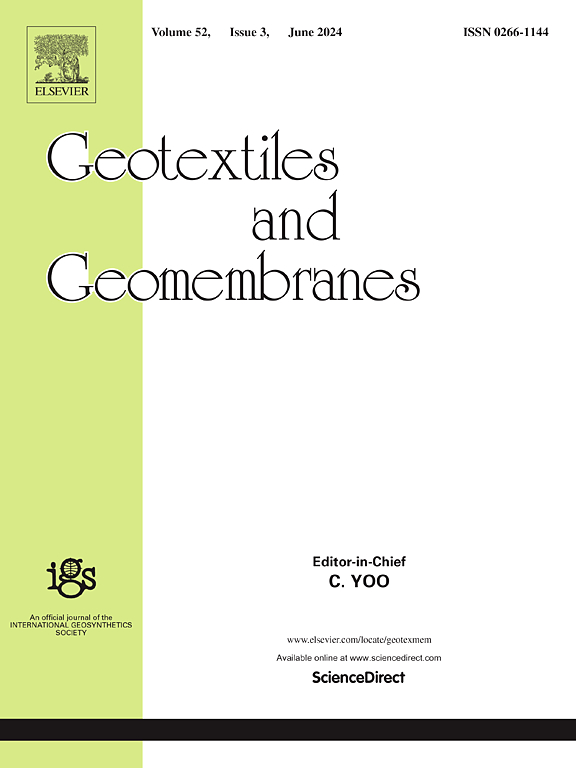土工格室加固基础系统的荷载诱发应变分析
IF 6.2
1区 工程技术
Q1 ENGINEERING, GEOLOGICAL
引用次数: 0
摘要
在基于性能的设计中,了解土工格室层在基础荷载作用下的变形特征是至关重要的。为此,开展了一系列室内加载试验,研究了轴向条形基础加载下不同参数对砂土土工格室层应变水平的影响。分析了最大应变水平、应变沿土工格室层的变化以及水平应变与垂直应变的相关性。在本研究中,土工格室加筋条形基础系统的最大观测应变水平在水平(拉伸)应变下达到2.3%,在垂直(压缩)应变下达到1.4%。大多数应变水平集中在距条形基础轴线1.5倍基础宽度范围内。在土工格室加固基础体系中,水平应变与竖向应变之间的相互作用成为关键因素,水平应变与竖向应变之比约为1 ~ 2.5。本研究结果有望为土工格室加固基础系统的实际应用做出贡献。本文章由计算机程序翻译,如有差异,请以英文原文为准。
Load-induced strain analysis in geocell reinforced footing systems
In performance-based design, it is crucial to understand deformation characteristics of geocell layers in soil under footing loads. To explore this, a series of laboratory loading tests were carried out to investigate the influence of varying parameters on the strain levels within the geocell layer in a sandy soil under axial strip footing loading. The results were analyzed in terms of maximum strain levels, strain variation along the geocell layer and the correlation between horizontal and vertical strains. In this study, the maximum observed strain levels for geocell-reinforced strip footing systems reached 2.3 % for horizontal (tensile) strain and 1.4 % for vertical (compressive) strain. Furthermore, most strain levels were concentrated within a distance of 1.5 times the footing width from the axis of strip footing. In geocell-reinforced footing systems, the interaction between horizontal and vertical strains becomes a key factor, with the ratio of horizontal to vertical cell wall strains ranging approximately from 1 to 2.5. The outcomes of this study are expected to contribute to the practical applications of geocell-reinforced footing systems.
求助全文
通过发布文献求助,成功后即可免费获取论文全文。
去求助
来源期刊

Geotextiles and Geomembranes
地学-地球科学综合
CiteScore
9.50
自引率
21.20%
发文量
111
审稿时长
59 days
期刊介绍:
The range of products and their applications has expanded rapidly over the last decade with geotextiles and geomembranes being specified world wide. This rapid growth is paralleled by a virtual explosion of technology. Current reference books and even manufacturers' sponsored publications tend to date very quickly and the need for a vehicle to bring together and discuss the growing body of technology now available has become evident.
Geotextiles and Geomembranes fills this need and provides a forum for the dissemination of information amongst research workers, designers, users and manufacturers. By providing a growing fund of information the journal increases general awareness, prompts further research and assists in the establishment of international codes and regulations.
 求助内容:
求助内容: 应助结果提醒方式:
应助结果提醒方式:


